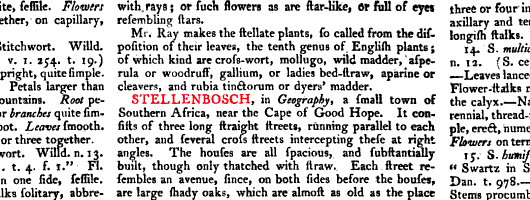
About Andrew Cusack
 Writer, web designer, etc.; born in New York; educated in Argentina, Scotland, and South Africa; now based in London.
Writer, web designer, etc.; born in New York; educated in Argentina, Scotland, and South Africa; now based in London. read more
News
Blogs
Reviews & Periodicals
Arts & Design
World
France
Mitteleuropa
Knickerbockers
Argentina
The Levant
Africa
Cape of Good Hope
Netherlands
Scandinavia
Québec
India
Muscovy
Germany
Academica
Stellenbosch in the ‘Cyclopædia’

Over at afrikaans.be, Anton Raath posts a verbal snapshot of Stellenbosch in 1819 from ‘The Cyclopædia: or universal dictionary of arts, sciences, and literature’:
STELLENBOSCH, in Geography, a small town of Southern Africa, near the Cape of Good Hope. It consists of three long straight streets, running parallel to each other, and several cross streets intercepting these at right angles. The houses are all spacious, and substantially built, though only thatched with straw.
Each street resembles an avenue, since, on both sides before the houses, are large sturdy oaks, which are almost as old as the place itself, which was built at the beginning of the former century, though it was wholly burnt down in 1710. In December, 1803, a similar accident happened, when the number of houses left standing was about 80. The church was built in 1722, and though not equal in size to the churches of Roodezant and Paarl, it is no way inferior to them in point of architecture.
The number of inhabitants at Stellenbosch, including slaves and Hottentots, is estimated at 1000. Every person in this town carries on, with his trade, some portion of agriculture and horticulture; and as there are none who can be called actually poor, who labour for hire, they are obliged to have slaves, who do not pay the expence of keeping them.
Strangers, who in their long voyages make any stay at the Cape, never fail to visit Stellenbosch; and people of property at the Cape Town also, in the fine season of the year, often make parties of pleasure to this fertile spot. Hence houses are fitted up here for the accommodation and entertainment of strangers.
“Hoe meer dinge verander…” Mnr Raath comments.
Search
Instagram: @andcusack
Click here for my Instagram photos.Most Recent Posts
- Gellner’s Prague December 19, 2024
- Monsieur Bayrou December 18, 2024
- Dempsey Heiner, Art Critic December 17, 2024
- Vote AR December 16, 2024
- Articles of Note: 12 December 2024 December 12, 2024
Most Recent Comments
Book Wishlist
Monthly Archives
Categories


